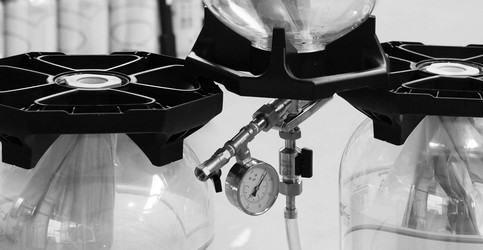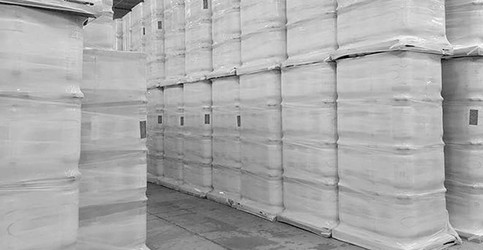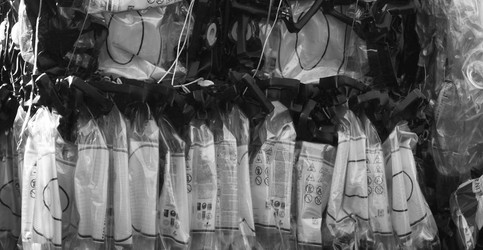What is a keg?
A Keg is the most popular and widely used pressured container for filling, holding, protecting and transporting beverages from producer to consumer. If you drink beverages from the tap in pubs, bars, cafés or restaurants, they are most likely dispensed from a Keg, which is stored and chilled underneath the counter, in the cellar or in another part of the building.
Kegs are designed to keep beverages fresh for as long as possible. They are made from various materials, mainly plastic or steel, and are available in different sizes to meet different needs. Various types, shapes, size and capacity of cylindrical Keg are on the market, so producers ask themselves what is a Keg that suits their needs, which is most efficient and effective for the supply chain and customers.

What types of Kegs can you use?
Most Kegs are made from plastic or steel (occasionally wood or aluminium). Each type has its pros and cons, whether it’s size, weight, cost, reusability, safety, need for return, cleaning, environmental impact and, most of all, how it protects beverage quality and flavour over time. KeyKeg, for example, is a strong, safe, lightweight and sustainable one-way, single-use plastic-Keg solution that is comparable with steel in terms of quality, freshness and shelf-life. KeyKeg benefits include reduced logistics and handling costs, less manual effort, recyclability rather than returnability, and it is circular by design. Common Keg capacities, like KeyKeg, are 10 L (2.64 US gal.), 20 L (5.28 US gal.) and 30 L (7.93 US gal.). KeyKegs also weigh significantly less than steel: 0.82–1.50 kg (1.81–3.31 US lbs).

Which types of beverages come in a keg?
Almost all types of beverage can be filled in Kegs, whether its beer, wine, cider, cocktails, RTDs, kombucha or coffee. Kegs can even be used as packaging for non-food liquids. Kegs are the ideal beverage and liquid packaging because they are convenient. Tapping multiple Kegs with different capacities from diverse producers around the world allows hospitality outlets to offer a broad range of beverages that are guaranteed to be fresh, long after they are produced. Kegs give consumers more choice. As retail trends, consumer choice and environmentally focused legislation promotes sustainable packaging, Kegs are the perfect container for shops and stores to offer customers self-pour, self-decant liquid-based products and beverages in reusable bottles and containers. It is a growing market that favours sustainable packaging with green credentials.

How do I tap a Keg?
Pubs, bars, restaurants, events and other hospitality venues use a diverse range of dispense systems to pour their beverages. Finding the correct balance between dispense-gas pressure, distance between Keg and tap and carbonation level in the beverage can be a challenge, an art. However, the principles are the same. Beverage producers or specialist filling companies fill the Kegs, which are distributed to local hospitality venues or exported around the world. Frontline staff then connect a coupler to the Keg’s fitting and pour the beverage using a dispense gas, which forces the liquid from the Keg, through the pipes and tap into the consumer’s glass.
Each type of Keg may have its own unique fitting, coupler and connection method. Once a Keg is empty and needs to be replaced with a filled one, frontline staff must know more than just what is a Keg, they must be familiar with the correct processes: disconnecting and connecting Kegs, resetting foam on beer detectors (FOBs) if present and how to change couplers if a new beverage is being tapped.

Do all kegs use the same fitting and coupler?
Kegs come with a diverse range of fittings, each of which requires a unique coupler to ensure beverages can reach the tap. The type of fitting depends upon several factors, including region and how the dispense gas interacts with the beverage. Some Kegs feature an inner tube, called a spear, so the correct fitting-coupler combination applies the dispense gas directly to the beverage surface, forcing the beverage up the spear towards the tap. With this approach the type of dispense gas and pressure is important, as the gas directly influences the beverage: its quality and carbonation.
Other Kegs use a self-contained inner bag, which keeps dispensed gas and beverage separate. With this approach, any dispense gas can be used, even compressed air, since the gas does not directly interact with the beverage — CO2, N2 or mixed gas are unnecessary. Using the Bag-in-Keg approach, dispense gas squeezes the bag, forcing the beverage through the unique coupler towards the tap.

How are Kegs transported?
Kegs can be distributed using any form of transport, including by sea or air for exports. Keg weight is therefore very important. The lighter the Keg, the more beverage can be transported per load. Making fewer deliveries or transporting more per delivery reduces transport costs, saves fuel and can be better for the environment. Also, the lighter the Keg, the easier it is to handle.
Filled lightweight Kegs can be moved easily by hand without any equipment, which makes life easier (and safer) for staff. Some reusable Kegs that are made from expensive materials like steel need to be returned to the producer, which means higher transport costs, risk of loss or damage, and the need for intense cleaning routines that use expensive energy and other resources. Single-use, one-way Kegs can either be simply added to local recycling programmes or, in the case of circular-by-design Kegs, can be recycled to actually recover and reuse the raw materials in new Kegs.

All you need to know when using Kegs
When deciding what is the Keg most suitable for you, it is worth remembering that whatever type of Keg you use, many tapping principles and dispense problems are universal. For example, Kegs should always be chilled adequately in a chiller, refrigerator or kegerator before tapping or pouring to avoid dispense problems and warm beverages for customers. The type of dispense system and pressure also determines what happens when a Keg is empty: sometimes flow will simply stop, whereas in other cases the beverage will start to foam. Dispense and dispense-system troubleshooting guides are widely available; following these correctly will help extend the lifespan of beverages in an opened (tapped) Keg. Troubleshooting mostly revolves around temperature, dispense pressure, beverage type and carbonation level. The KeyKeg guide is a great place to get started.
A Keg’s lifespan and cost depends upon the material used: with repairs, good management and safekeeping, expensive steel Kegs may last forever; some plastic Kegs are single-use and cheap; other plastic Kegs are circular and designed so that the raw materials can be continually reused to make new Kegs.

Are beverage Kegs sustainable?
All but the very cheapest Kegs are sustainable, although the level and type of sustainability is different. Low-end Kegs tend to end up with domestic or commercial waste, incinerated or used as landfill — not sustainable. Some Kegs claim to be ‘recyclable’, which simply means they end up in domestic or commercial recycling schemes and incinerated to generate energy (thermal recycling) — not truly sustainable. Steel Kegs are designed to be reused continually — sustainable, although they require more transport and intensive cleaning.
The raw materials in circular-by-design Kegs can be recovered through proper recycling to be continually reused in new Kegs — sustainable, although more empty Kegs need to be collected to increase the overall circularity. The most modern beverage Kegs are those that continue to innovate, are practical and versatile and consider their environmental impact on the planet.
KeyKeg is a circular-by-design, innovative beverage-packaging Keg that puts the planet first. It is lightweight, which reduces transport and costs, and it removes the need for certain dispense gas like CO2, which is expensive and bad for the environment. KeyKeg’s raw materials can also be continually reused. Furthermore, KeyKeg offers superior beverage-quality retention and extended shelf-life. It is strong, safe and easy-to-handle: ergonomic, stable and stackable. And unlike other types of Kegs, KeyKeg can be provided with custom sleeves that promote your beverage brands.

Tap into practical, versatile KeyKeg knowledge!
Your dedicated Account Manager knows all there is to know about KeyKeg practicality, versatility and much more. Make a connection today and add more value to your beers, wines, ciders, kombucha, coffee, RTDs and cocktails.
NATALIE MAESTRI
Sales Manager UK & Ireland

Tap into practical, versatile KeyKeg knowledge!
Your dedicated Account Manager knows all there is to know about KeyKeg practicality, versatility and much more. Make a connection today and add more value to your beers, wines, ciders, kombucha, coffee, RTDs and cocktails.
CATHY KERSSEMEIJER
Senior Account Manager Nordics & Eastern Europe

Tap into practical, versatile KeyKeg knowledge!
Your dedicated Account Manager knows all there is to know about KeyKeg practicality, versatility and much more. Make a connection today and add more value to your beers, wines, ciders, kombucha, coffee, RTDs and cocktails.
MARC KIBBEY
Account Manager USA

Tap into practical, versatile KeyKeg knowledge!
Your dedicated Account Manager knows all there is to know about KeyKeg practicality, versatility and much more. Make a connection today and add more value to your beers, wines, ciders, kombucha, coffee, RTDs and cocktails.
SAMUEL GRACZYK
Account Manager USA

Tap into practical, versatile KeyKeg knowledge!
Your dedicated Account Manager knows all there is to know about KeyKeg practicality, versatility and much more. Make a connection today and add more value to your beers, wines, ciders, kombucha, coffee, RTDs and cocktails.
RAYMOND KENT
Account Manager Australia, Middle East & Asia


